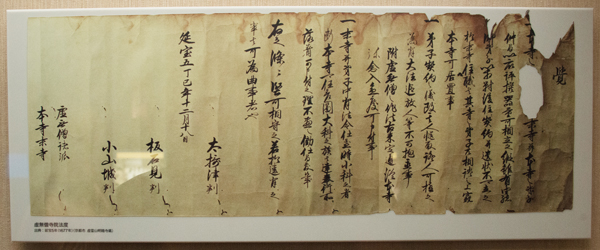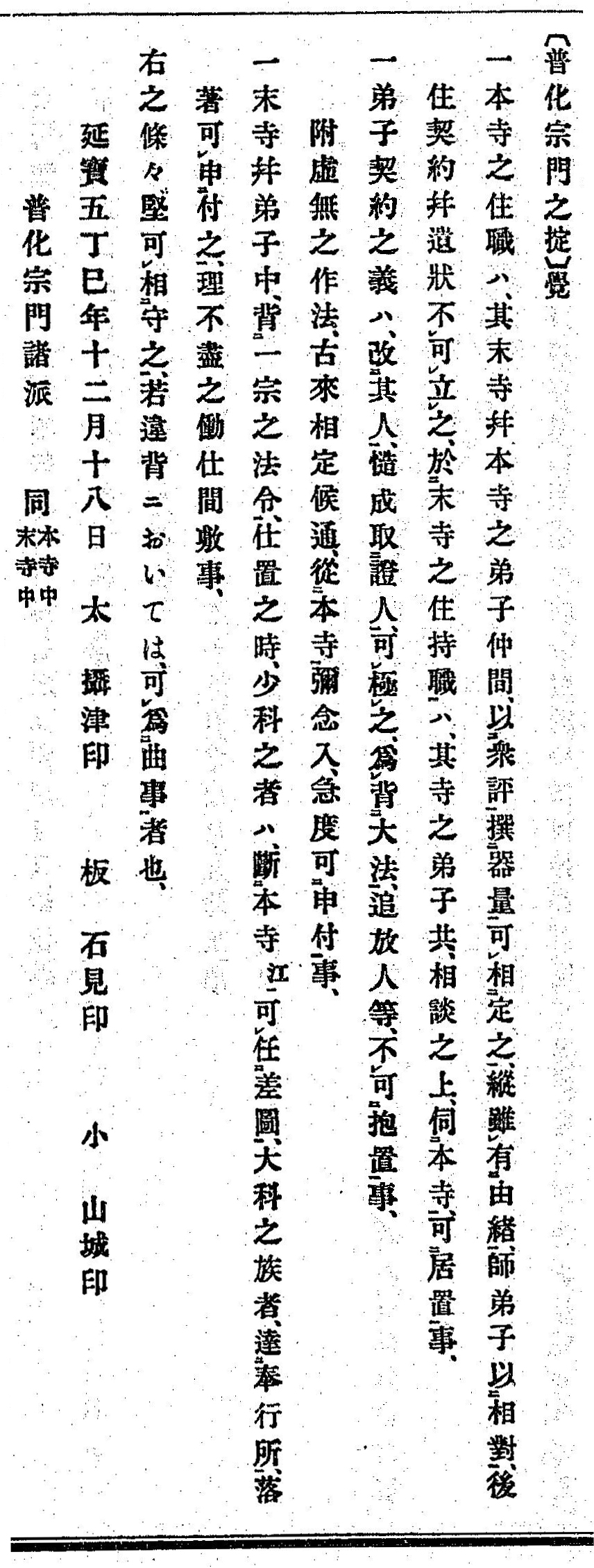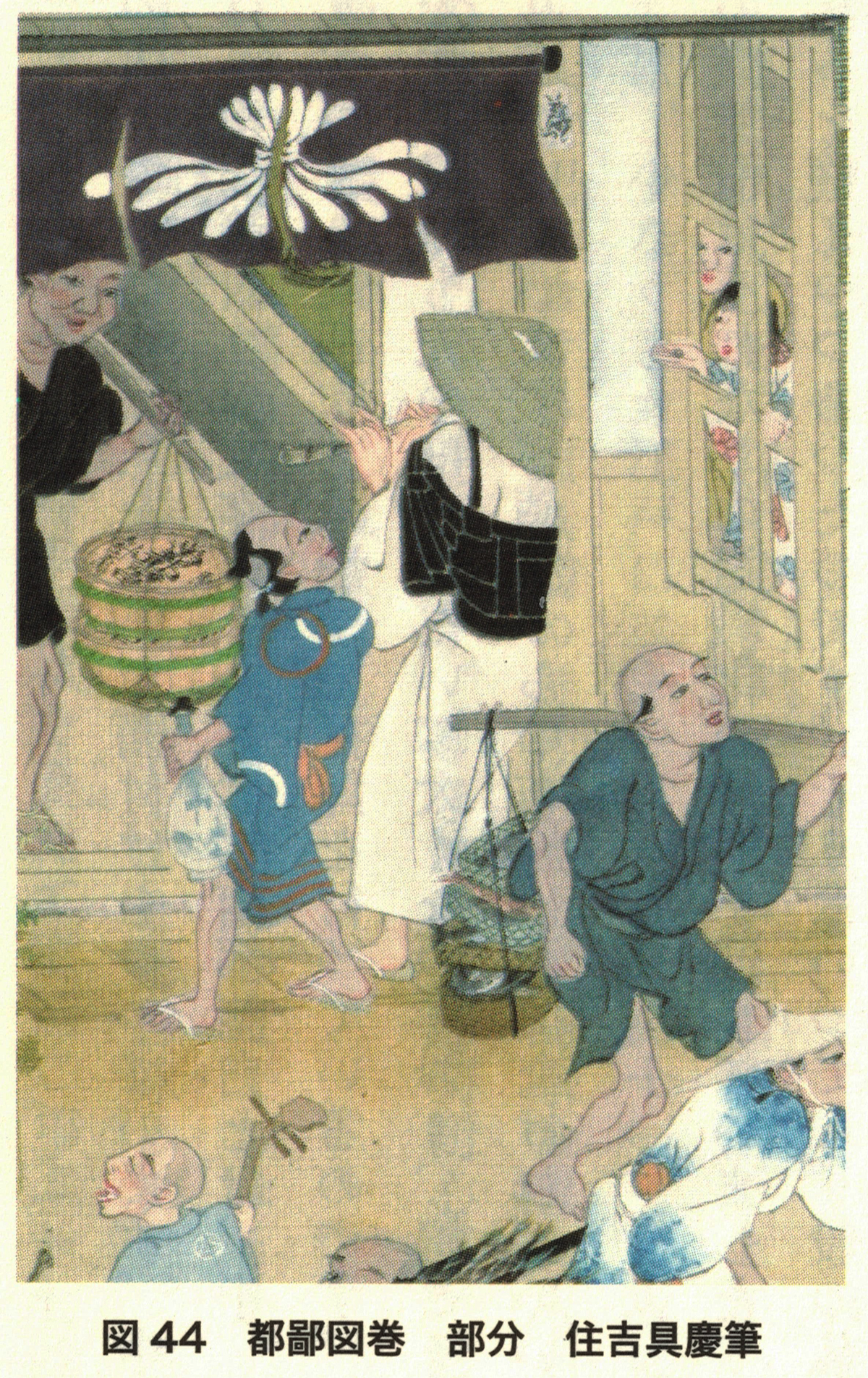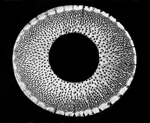|
1678: The Enpō 5, 12th Month, 18th Day, Komusō-ha Oboe
Bakufu Memorandum of January 11th, 1678
覚 - OBOE - "Memorandum"
This webpage was revisited, edited - and sharpened - as of October, 15, 2024.
Do note: This is definitely not a 'kōnin', 公認,
an "official governmental authorization", as a majority of "traditionalistic" shakuhachi historians - East & West - do very much like to call it!
This short memorandum does not in any way connect the 'Komusō' with the Rinzai Zen Sect!
It is rather just a short notification of certain basic guidelines for some then pretty small, local and only loosely knit groups
of temporarily, or perhaps life long, now masterless former members of the samurai class.
The document may even have been fabricated by the 17th century early 'Komusō' themselves
in order to somehow legitimize their 'shakuhachi' playing beggar lifestyle and activities?
It is essential to note that the document is addressed to "All Komusō Branches" (or, "Factions"):
'Komusō sho-ha', 虚無僧諸派
- and definitely not to any "Fuke Sect" branches, factions, or parties, at all.
Also, do note that a piece of the document scroll is missing in the top right corner.
That is where Japanese shakuhachi historians may later have proposed/inserted (?) the term 'jū-shoku',
住職, "chief Buddhist monk".
Again, do note: You do not see the slightest mention of any relation to the Rinzai Zen Buddhist establishment
in this 'Enpō 5' 'Komusō' Document at all.
There is no reference to any "Fuke Sect", 'Fuke-shū',
普化宗,in the document.
And, not least: No documentary evidence presented here at all that 'Komusō' were in any way "Zen monks", for that matter!
Here you see an annotated reprint of a however very significant - yet disputed - Komusō Shakuhachi related document
that is exhibited in copy in the Komusō Room of the Matsudo City Museum in NW Chiba Prefecture.
This is the vicinity in which the memorable 'Komusō' temple Ichigetsu-ji was located during the Edo Period
after it had been established there at some time during the last quarter of the 17th century, or so.

覚 - 'Oboe'
- Annotated reprint of the socalled "Edict of the Enpō Period"
Photo taken by Ronald Nelson in Summer 2014.
This document is generally being regarded, accepted and highly respected as presenting full and reliable evidence of the socalled
"Fuke Sect" having been officially recognized and authorized by the "Temples & Shrines Magistrate Department" in Edo -
and thus the Tokugawa Bakufu régime - towards the ultimate close of the 5th year of the Enpō Period (1673-1681).

Click in the photo to enlarge.
The above picture appears to show one existing photographic reproduction of an actual, original Oboe, or "Memorandum", document.
According to the small sign under the picture, it is a treasure of the Myōan Temple in Kyōto.
Both photos were most kindly taken by Ronald Nelson of the International Shakuhachi Society at the Matsudo City Museum in Summer 2014.
覚
一 本寺之 (住職者) 其末寺并本寺之弟子
仲間 以衆評 撰器量 可相立之
縦雖有由緒師弟子以相対
後 住契約并遺状 不可立之
於末寺住職者 其寺之弟子共相談之上窺
本寺 可居置事。
一 弟子契約之儀 改其人 慥取証人 可極之
為背大法追放人等 不可抱置事。
附 虚無僧之作法 古来定通 従本寺
弥 念入 急度 可申付事。
一 末寺并弟子中 背法令 仕置時 小科之者
断本寺 可任指図 大科之族者 達奉行所
落着可申付之 理不盡之働 仕間敷候事。
右之條〃 堅可相守之 若 於違背之
輩者 可為曲事者也
太 摂津 判
延宝五丁巳年十二月十八日
板 石見 判
小 山城 判
虚無僧諸派
本寺末寺
ENGLISH TRANSLATION
By Torsten Olafsson as of August 2, 2016 - revisited and checked on October 15, 2024.
MEMORANDUM
(1-a)
The [? chief monk of a/the head temple ?] must be elected and appointed from among the disciples of the highest standard in the sub temples and the head temple(s).
(1-b)
Even if there exists a master-disciple relationship [possibly, between two 'rōnin komusō'?],
that must not be allowed any influence on the selection and written appointment of a chief monk.
(1-c)
As for the chief monk of a sub temple he must report to the head temple in case there arises a dispute or a conflict among that temple's disciples.
(2-a)
At the time of accepting (or, contracting with) a [new] disciple, that person's background and identity must be certified and confirmed in formal writing
by a [or, by one or more] witness(es) before a final decision [can be settled].
(2-b)
Convicted and banished persons who have acted contrary to the fundamental laws must be arrested and taken prisoners (or, taken into custody].
(2-c)
Even so more, the head temple must definitely and thoroughly so instruct that the etiquette (or, manners) of the 'Komusō' since times of old
be ever increasingly observed and respected.
(3-a)
At the time when a sub temple and/or a disciple are to be punished for having acted against the laws,
minor offenders are to make a humble plea to the head temple and accept the resulting mandate.
(3-b)
Persons who have committed serious wrongdoing must be handed over to the government magistrates, for their official judgement in the matter.
(3-c)
Outrageous behaviour that is not in accordance with the underlying Principles of the Cosmos [acc. to Neo-Confucianism] is not acceptable [lit., does not serve].
(4-a)
The above paragraphs must be firmly observed and obeyed.
(4-b)
If they are violated that is very unlawful.
(4-c)
Enpō 5th, the 'hinoto mi' year, 12th month, 18th day *)
= January 11, 1678, year of the cyclic sign 'hinoto mi' *)
Ōta Settsu no Kami [seal] **)
Governor Director ['Kami'] of the Settsu Province (SE part of Hyōgo Prefecture
and the Northern part of Ōsaka Prefecture)
Itakura Iwami no Kami [seal] ***)
Governor Director ['Kami'] of the Iwami Province (Western part of Shimane Prefecture)
Koide Yamashiro no Kami [seal] ****)
Governor Director ['Kami'] of the Yamashiro Province (Southern part of Kyōto Prefecture)
(To) All 'Komusō' Factions
Mother Temple[s]
Sub Temple[s]
Preliminary notes:
*) The cyclic sign 'hinoto mi', 丁巳, is not correct for this date.
The cyclic sign for Enpō 5-12-18 should be 'tsuchinoe uma', 戊午!
Direct link to the online Zöllner & Tsuchihashi Year Period and Cyclic Sign Calculator & Generator
**) Personal name: Ōta Suketsugu, 太田 資次;
in office as Temples & Shrines Magistrate in 1676-1678.
***) Personal name: Itakura Shigetane, 板倉 重種;
in office as Temples & Shrines Magistrate in 1677-1680.
****) Personal name: Koide ???, 小出 ?
Do note that there was no person with the family name 'Koide' in office in Enpō 5!
However, in fact a certain Ogasawara Yamashiro no Kami, 小笠原 山城 守,
personal name: Ogasawara Naganori, 小笠原 長矩,
was indeed in office as Temples & Shrines Magistrate in 1666-1678.
Source: WikiPedia: Jisha bugyō
Torsten Olafsson
Elsinore, Denmark
August 2nd, 2016
The late 1800s Koji ruien editors falsified the Enpō 5 Oboe Memorandum!


When the Meiji Government's late 1800s Koji ruien encyclopedia board of editors chose and prepared selected textual material for a chapter on the topic 'Fuke-shū',
普化宗,
deliberately or not, they falsified one particular important document in a way that would inevitably change, distort and pollute the writing of shakuhachi and 'komusō' history for more than a century.
When preparing the 'Enpō 5 Oboe' for printing, the editors in charge changed the original 'Oboe' Memorandum's
虚無僧諸派, 本寺中, 末寺中,
"(Addressed) to All 'Komusō' Branches, Head Temples, Sub Temples",
into that of
普化宗門諸派, 同本寺中, 末寺中,
"(Addressed) to All 'Fuke Shūmon' Branches, Both Head Temples and Sub Temples".
If that is not "falsification of a historical document", tell me ...
ENGLISH TRANSLATION
by Torsten Olafsson, checked and ipdated on October 15, 2024
MEMORANDUM
(1-a)
The [? chief monk of a/the head temple ?] must be elected and appointed from among the disciples of the highest standard in the sub temples and the head temple(s).
(1-b)
Even if there exists a master-disciple relationship [possibly, between two 'rōnin komusō'?],
that must not be allowed any influence on the selection and written appointment of a chief monk.
(1-c)
As for the chief monk of a sub temple he must report to the head temple in case there arises a dispute or a conflict among that temple's disciples.
(2-a)
At the time of accepting (or, contracting with) a [new] disciple, that person's background and identity must be certified and confirmed in formal writing
by a [or, by one or more] witness(es) before a final decision [can be settled].
(2-b)
Convicted and banished persons who have acted contrary to the fundamental laws must be arrested and taken prisoners (or, taken into custody].
(2-c)
Even so more, the head temple must definitely and thoroughly so instruct that the etiquette (or, manners) of the 'Komusō' since times of old
be ever increasingly observed and respected.
(3-a)
At the time when a sub temple and/or a disciple are to be punished for having acted against the laws,
minor offenders are to make a humble plea to the head temple and accept the resulting mandate.
(3-b)
Persons who have committed serious wrongdoing must be handed over to the government magistrates, for their official judgement in the matter.
(3-c)
Outrageous behaviour that is not in accordance with the underlying Principles of the Cosmos [acc. to Neo-Confucianism] is not acceptable [lit., does not serve].
(4-a)
The above paragraphs must be firmly observed and obeyed.
(4-b)
If they are violated that is very unlawful.
(4-c)
Enpō 5th, the 'hinoto mi' year, 12th month, 18th day *)
= January 11, 1678, year of the cyclic sign 'hinoto mi' *)
Ōta Settsu no Kami [seal] **)
Governor Director ['Kami'] of the Settsu Province (SE part of Hyōgo Prefecture
and the Northern part of Ōsaka Prefecture)
Itakura Iwami no Kami [seal] ***)
Governor Director ['Kami'] of the Iwami Province (Western part of Shimane Prefecture)
Koide Yamashiro no Kami [seal] ****)
Governor Director ['Kami'] of the Yamashiro Province (Southern part of Kyōto Prefecture)
(To) All 'Komusō' Factions
Mother Temple[s]
Sub Temple[s]
Notes:
*) The cyclic sign 'hinoto mi', 丁巳, is not correct for this date.
The cyclic sign for Enpō 5-12-18 should be 'tsuchinoe uma', 戊午!
Direct link to the online Zöllner & Tsuchihashi Year Period and Cyclic Sign Calculator & Generator
**) Personal name: Ōta Suketsugu, 太田 資次;
in office as Temples & Shrines Magistrate in 1676-1678.
***) Personal name: Itakura Shigetane, 板倉 重種;
in office as Temples & Shrines Magistrate in 1677-1680.
****) Personal name: Koide ???, 小出 ?
Do note that there was no person with the family name 'Koide' in office in Enpō 5!
However, in fact a certain Ogasawara Yamashiro no Kami, 小笠原 山城 守,
personal name: Ogasawara Naganori, 小笠原 長矩,
was indeed in office as Temples & Shrines Magistrate in 1666-1678.
Source: WikiPedia: Jisha bugyō
Torsten Olafsson
Elsinore, Denmark
August 2nd, 2016
An Enpō Period shakuhachi-playing mendicant 'komusō'?
Before or after 1690? - perhaps even some time before 1683?:

A 'Komusō' playing a root-end shakuhachi in a Kyōto street
Detail from the 'Tohi zumaki', 都鄙図巻, "Town & Country Picture Scroll".
A very long and impressive picture scroll painted on silk. By Sumiyoshi Gukei, 1631-1705
Originally a treasure of the Konbu-in in Nara, now exhibited at (link)
Tōkyō National Museum
Sumiyoshi Gukei was born and lived in Kyōto until 1683 when he moved to Edo, present day Tōkyō, where he died in 1705.
In: Izumi Takeo, 2013, p. 93.
| |





